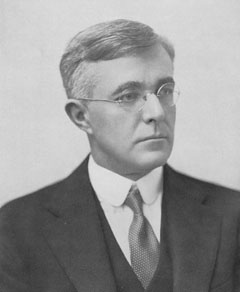| Irving Langmuir  Born: 31-Jan-1881 Born: 31-Jan-1881
Birthplace: Brooklyn, NY
Died: 16-Aug-1957
Location of death: Woods Hole, MA
Cause of death: Heart Failure
Gender: Male
Religion: Agnostic [1]
Race or Ethnicity: White
Sexual orientation: Straight
Occupation: Chemist, Physicist Nationality: United States
Executive summary: Inventor of the high-vacuum tube American chemist and physicist Irving Langmuir was nearly blind for the first eleven years of his life, until his vision problems were diagnosed and he was fitted with glasses at the age of 11. He soon showed a remarkable affinity for science, and as a young man he attended the University of Göttingen and studied under Walther Nernst. He taught for several years at a small college in Hoboken, New Jersey, until 1909, when he took summer work at General Electric's research labs. He quickly came to the attention of the unit's manager, who offered a permanent position at a higher wage than Langmuir's teaching job paid. In his long career at GE, Langmuir was given extraordinarily wide latitude to explore whatever intrigued him. In 1932 he became the first industrial chemist to win the Nobel Prize in Chemistry, for his 1919 concentric theory of atomic structure, detailing the chemical forces at the boundaries between different substances.
His other career landmarks include the 1912 invention of the high-vacuum electron tube, later used extensively in broadcasting, and his 1913 study of the high-temperature surface chemistry of tungsten, which led to his invention of a gas-filled incandescent lamp that was much longer-lasting than previous tungsten-filament bulbs. He coined the term covalence in about 1915, a reference to the number of electron pairs an atom can share with other atoms. In 1927 he became the first scientist to use the term plasma to describe an ionized gas, and in the same year he invented a hydrogen blowtorch for welding metals at extreme high temperatures. In 1946, with Vincent Schaefer, he discovered that clouds can be seeded with dry ice and iodide to trigger a reaction producing rain or snow. He also conducted respected research into aircraft de-icing techniques, chemical bond formation, filtration, heat transfer, incandescent lamps, low-pressure phenomena, non-reflecting glass, octet atomic theory, thermionic phenomena, smokescreen generators, and submarine sonar.
He is the namesake of the Langmuir isotherm (sometimes called the Langmuir adsorption equation), a mathematical expression of the relationship between gas pressure at constant temperatures and the amount of adsorption on a surface, and of Langmuir cells, long, rotating "cells" of water predicted by Langmuir many years before their actual discovery. An accomplished mountain-climber, he is also the namesake of an Alaskan peak, Mount Langmuir. He was an uncle to epidemiologist and Centers for Disease Control co-founder Alexander D. Langmuir (1910-93), and a friend and frequent flying companion of Charles Lindbergh. Kurt Vonnegut worked briefly in Langmuir's lab at GE, and years later said that Langmuir had been the inspiration for Dr Felix Hoenikker, the central character in Vonnegut's satirical science-fiction novel Cat's Cradle.
[1] About his inattention to religion, his usual response was, "Never believe anything that can't be proved."
Father: Charles Langmuir
Mother: Sadie Comings Langmuir
Brother: Arthur Langmuir (chemist)
Wife: Marion Mersereau Langmuir (m. 1912, one son, one daughter)
Son: Kenneth Langmuir
Daughter: Barbara Langmuir
High School: Chestnut Hill Academy, Philadelphia, PA (attended)
High School: Pratt Institute's Manual Training High School, Brooklyn, NY (1899)
University: BS Metallurgical Engineering, Columbia University (1903)
University: MA Chemistry, University of Göttingen (1906)
University: PhD Chemistry, University of Göttingen (1906)
Teacher: Chemistry, Stevens Institute of Technology (1906-09)
General Electric Research scientist, Schenectady, NY (1909-50)
Nichols Medal 1915
Hughes Medal 1918
Nichols Medal 1920
Rumford Prize 1920
Cannizzaro Prize of the Accademia dei Lincei 1925
Perkin Medal 1928
Chandler Medal 1929
Willard Gibbs Medal 1930
Nobel Prize for Chemistry 1932
Benjamin Franklin Medal 1934 (by the Franklin Institute)
ASME Holly Medal 1934
John Scott Medal 1937
IET Faraday Medal 1944
Mascart Medal of the Societe Francaise des Electriciens 1950
American Academy of Arts and Sciences
American Physical Society
American Chemical Society President (1929)
American Association for the Advancement of Science President (1943)
British Chemical Society Foreign Member
Royal Society Foreign Member
Tau Beta Pi Engineering Honor Society
Heart Attack 16-Aug-1957 (fatal)
Lunar Crater Langmuir (35.7° S 128.4° W, 91 km. diameter)
National Inventors Hall of Fame 1989
Appears on the cover of:
Time, 28-Aug-1950
Author of books:
Phenomena, Atoms and Molecules (1950, non-fiction)
The Collected Works of Irving Langmuir (1961, papers; 12 volumes)
Requires Flash 7+ and Javascript.
Do you know something we don't?
Submit a correction or make a comment about this profile
Copyright ©2019 Soylent Communications
|